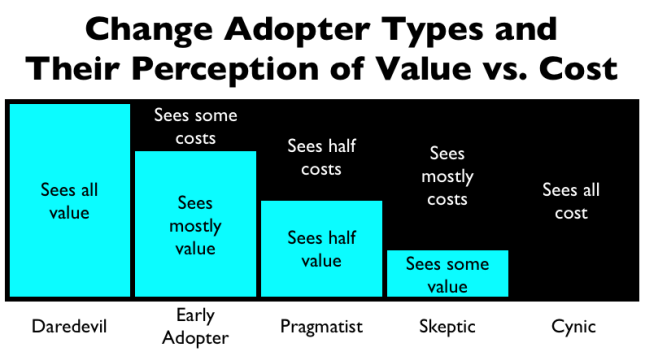 It’s the age-old “optimist or pessimist” question: do you see this glass as half-empty or half-full? As it turns out, there are a variety of ways to answer that question outside of the “either/or” choice provided, and that could tell you a lot more about how you (and those around you) perceive the world.
It’s the age-old “optimist or pessimist” question: do you see this glass as half-empty or half-full? As it turns out, there are a variety of ways to answer that question outside of the “either/or” choice provided, and that could tell you a lot more about how you (and those around you) perceive the world.
For instance, this website contains a collection of funny one-liners imagining different professions answering the question. An engineer might see a glass that’s twice as big as it needs to be, while an entrepreneur sees a glass undervalued by half its potential.
West Wing fans may remember White House speech writer (and noted grumpy-pants) Toby Ziegler’s passionate response: “Half-full, half-empty- can we at least agree it’s not full yet?”
And when I’m asked that question, I generally respond with a smarty-pants science guy answer: “You know, the glass is ENTIRELY full. It’s just half-filled with water, and half-filled with air!” #nerdalert, I know.
Those who know me (and have read other posts on this blog, like this one and this one) know that I think about organizational change a lot, specifically through a reasonable facsimile of Rogers’ Diffusion of Innovation work. This metaphor recently came to mind, and I thought it might be interesting to consider how I would imagine five aforementioned “adopter types” responding to this question:
If you had this glass of water, what would you do with it?
- The Daredevil: “We’ve got some water- let’s drink it! Or splash it! Or pour it on our heads! Or we could float something in it! Wait- AND WE’VE GOT A GLASS, TOO? Let’s see what we could do with that!”
- The Early Adopter: “I say we drink the water so we can keep on pressing forward and be better hydrated. And I heard that guy over there talk about what he was going to do with the glass- I hadn’t thought of that as a resource. Once we finish our water, let’s keep the glass and fill it the next chance we get!”
- The Pragmatist: “Well, let’s see. It’s looking like it’s half-empty…but it’s also half-full. What are we going to do with this water? I’m really not sure. I want to make sure I’m putting it to good use, so if I could see someone else use this water successfully, then I’d feel a lot better about doing anything with it.”
- The Skeptic: “You know, it’s not really THAT much water. I mean, we could drink it, but then it would all be gone! I’m thinking we hold on to it- keep the water we have, and make sure we have it available when the time strikes. I’d hate to be in a situation where I really needed water and there was none to be had.”
- The Cynic: “Wait…you call that A GLASS OF WATER? That’s NOTHING. And besides, I can’t believe someone would dirty an entire glass, drink a half of it, and then just leave the rest sitting out. What is their problem? I seriously do not understand why people can’t just well enough alone.”
It’s kind of funny to read in this context, but I really do think that this little vignette encapsulates the wide variety of perceptions that different people tend to have about the exact same reality in the face of potential change.
Writing this post was inspired by an Oscar Wilde quote: “What is a cynic? Someone who knows the price of everything and the value of nothing.” My contention is that change adoption types tends to correlate to their recognition of perceived value versus perceived cost. My thinking is that this continuum of adoption types follows a relatively linear progression that balances perceived value and perceive cost in a given situation:
So, what does this all mean for leaders wrestling with organizational change?
- Come to grips with your own lens. How do you tend to perceive the situations your organization faces? Are you more of a Daredevil, seeing only the value of change without any of the costs? Or perhaps more like the Skeptic, noticing many more of the costs from the outset? Understanding yourself may become a window into your own values when it comes to leading change, and could help you uncover potential blind spots you might not naturally see.
- Incorporate the viewpoints of counter-perspectives into your own vision. It can be a challenge to let your inner voice be quiet enough to recognize the truths in what you hear in viewpoints opposing your ideas for change. That does not make these viewpoints any less valid. If you tend to see the “glass half full,” go find a Skeptic who easily sees inherent costs, and present them with your idea for change. Holes will be poked, no doubt. But these are holes that you can fill, which will make your plan much richer as a result.
- Listen for the lens that others are using, and let it inform your communications. The better you can understand others, the more likely you know how to engage them in the change process. Know a Daredevil who always tends to “jump right in”? Recognize that they’ll jump right in (though be wary if they don’t, and ask them why they didn’t). Pragmatists, however, may need a model before they’ll consider changing- consider enrolling your Early Adopters to help you build one. And the Cynics? They may never enroll- not until the change no longer looks like a change.
 When considering this post through another lens, a different kind of “change” came to mind: Which to choose, Heads or Tails? A quippy quote:
When considering this post through another lens, a different kind of “change” came to mind: Which to choose, Heads or Tails? A quippy quote:
Let’s stop arguing “either/ors” of heads & tails and realize what we have is one coin. Then we can spend our time figuring out what that coin is worth.

Great work!
Reference to the coin made simple “cents” Especially have a PD day experience as we move to shift our culture. Thanks!
Thanks, Cat- hope that your PD day goes well!
Brilliant and humorous! I love how you always bring the two together…
Thanks, Kristen! That little vignette of different adopter types’ “voices” feels like it’s turned into its own little stand-up routine- one of those “that’s SO true!” kind of laughs.
I love this scale, Tony. In this lexicon, I worry that the overwhelming political presence in schools’ work has increased the level of cynicism, making any change very difficult, regardless of where it comes from. Wrapping people’s heads around what it’s going to take to gain hearts and minds these days is so important. Thank you!
Thanks, David! It’s been interesting to think about, develop, and implement models for change that are actually based on how people approach it- helps us to recognize the “why” of the practices we implement. I would totally agree with you that the political landscape increases the relative cynicism, though I do tend to notice that there’s a marked difference in that level / degree of cynicism that seems to correlate to leadership practices by formal and informal leaders in the buildings / districts. Something that all of us really needs to consider in how we approach “getting people on board” / enrolling people in the idea of change.
PS Just ran across this article that describes 3 qualities of people who drive transformational change: courage, the ability to reframe the problem, and a sense of urgency: http://www.inc.com/ekaterina-walter/3-qualities-of-people-who-drive-transformative-change.html?cid=sf01002 How do you think these qualities apply to this model? Curious…